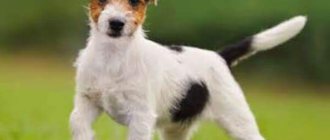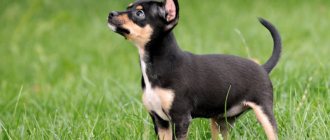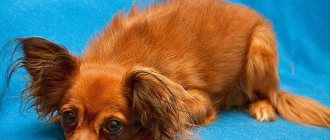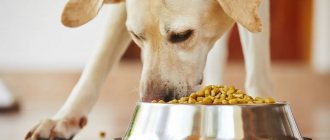Caring for an American Staffordshire Terrier is not particularly difficult. However, as is the case with other breeds, the owner must pay special attention to the pet’s diet, since proper and healthy nutrition is the key to the pet’s longevity.
A staff's diet should consist of a high percentage of meat.
General rules for feeding a dog
The Staffordshire Terrier is a muscular and powerful dog that needs constant exercise and quality food. It is a balanced diet that allows the animal to maintain its normal shape.
There are several general rules that the owner must follow when feeding his four-legged friend:
- It is mandatory to have food enriched with proteins, fats and carbohydrates in the menu, as they affect the functioning of internal organs and help gain muscle mass.
- When purchasing a puppy from a breeder, you should ask about its diet and adhere to the recommendations received for the first few weeks.
- All new products are introduced gradually, observing the condition of the puppy. Allergies in Staffies are rare, but its possibility cannot be ruled out.
- Your dog should always have clean water in his bowl. During the day, an adult dog drinks about one liter of water.
- An adult Stafford is fed twice a day - in the morning and in the evening after walks. You should not give food to your pet before walking it, as there may be a risk of intestinal volvulus.
It is necessary to develop rules for feeding the dog
Diet of an adult Staffordshire
The Staffordshire Terrier's diet remains meat: poultry, veal, rabbit, lean beef and offal. Proper natural nutrition is complemented by:
- cereals (except pearl barley porridge);
- fermented milk products (except milk);
- fresh egg or “light” omelette;
- fish base bones;
- meat and bone meal;
- vegetable slicing from pumpkin, carrots, cucumbers;
- greenery.
The amount of food for a Staffordshire Terrier is calculated individually (depending on gender, weight, activity).
Statistical calculation is performed using the formula: 25-35 g. feed per 1 kg of animal weight. The amount of liquid food should be taken at the rate of 35-55 g. per 1 kg. Additionally, vitamin supplements are purchased.
The staff should be fed twice a day – morning and evening. Leftover food is immediately thrown away. If your pet is switched to dry food, care must be taken to ensure access to water. After eating, dogs drink a lot. Food for the Staffordshire Terrier is purchased only from premium or holistic brands. When purchasing, pay attention to:
- date of manufacture;
- manufacturer's company;
- composition of the product.
The Stafford should be fed twice a day, with 1 liter of water. The amount of one serving is calculated based on the weight of the pet and the data indicated on the product label.
The basis of the diet and feeding rules for the Staffordshire Terrier
Many owners wonder what to feed the Staffordshire Terrier and how to properly structure its diet, since the dog’s activity and health depend on this.
Calculating the menu for the day is not difficult: it is necessary to take into account the age, gender, weight and activity of the animal. If industrial food is chosen, then per kilogram of the dog’s weight is up to 40 grams. stern. If natural nutrition is used, then per kilogram of animal weight is 50-60 grams. food.
Important! If the dog is highly active, then the amount of food will need to be increased by 15%, otherwise it will constantly feel hungry.
If the owner feeds the animal with natural food, then meat should be the basis of the diet. It can be served separately or with vegetables and cereals. The animal should also be given offal.
If, as a rule, there are no difficulties with feeding an adult dog, then the question of what to feed a Staffie puppy causes some difficulties for the owners.
So, the puppy’s diet should be based on vitamins such as A, B, C, D, E and microelements. When the need arises, you can add vitamin complexes, but in consultation with your veterinarian.
In relation to a breed such as the Staff, nutrition is a ritual that has its own rules:
- It is necessary to develop a schedule for eating and its duration. The dog should eat 2 times a day and at strictly designated times. It is unacceptable to leave the bowl in constant access.
- Dishes containing food and water should be placed on a stand. When eating, the head, neck and back should be in a straight line.
Important! Staff of any age should not be given pork; this meat is not suitable for them at all.
You can’t leave food in constant access to your staff.
BARF system for staff
The BARF diet is based on foods that Staffies would presumably eat in the wild. It includes:
- raw meat;
- various bird bones, except rib and tubular bones, soft lamb bones;
- offal;
- sea fish;
- raw vegetables, herbs, berries and fruits;
- dairy products;
- eggs.
In addition, various vegetable oils, fish oil, vitamins, and bran are added to the staff’s diet. Owners and staff of veterinary clinics note the huge advantage of such nutrition for dogs of any kind.
How and what to feed your pet is always decided by the owner himself. It is important that this is a complete diet that will not cause allergies, so this issue must be approached responsibly.
Inexperienced breeders believe that almost nothing depends on the quality and quantity of food. You can give your dog cheap food or cereal with the smell of meat, and it will grow and run.
In fact, each breed has different needs. Therefore, when thinking about what to feed the Staffordshire Terrier, you need to remember the purpose of the breed and its characteristics.
Plus, eating well doesn't mean it's expensive. Taking into account the recommendations of experienced dog handlers, you can create a healthy diet for your pet and prepare food yourself.
What type of food to choose
There are no clear recommendations on what to feed a Stafford, so the owner, at his discretion, can choose both industrial food and natural food.
Ready-made dog food
Many people choose dry food for the dog, because the option is convenient in that the owner does not have to spend time preparing food for the dog himself, carefully measuring the food. In addition, the finished product contains all the necessary substances for the normal functioning of the animal.
Ready-made food is purchased based on the age and activity of the dog. There are also products for staff with allergies and pathological diseases. As for the type of nutrition, it is best to purchase the holistic or super-premium class.
Natural products
The basis of the diet is meat, it should make up 55% of all food that your pet eats during the day. But you shouldn’t boil it, as this leads to loss of nutrients. It is best to pour boiling water over it before feeding and cut it into pieces.
Once or twice a week, meat is replaced with low-fat sea fish, which is offered raw.
Important! Care must be taken to ensure that there are no bones in the fish.
The menu should also include by-products, such as:
- lung;
- brain;
- heart;
- liver;
- language;
- udder;
- testes.
About 30% is occupied by vegetables. Of these we can offer:
- beets;
- carrot;
- pumpkin;
- zucchini;
- greenery.
The remaining percentage of the diet is occupied by vegetables (rice and buckwheat), fermented milk products, berries and fruits.
The dog should always have a full bowl of clean water.
What not to feed
It is necessary to know exactly not only what to feed the Amstaff, but also what is forbidden to give him:
- sweets;
- salty;
- fried and fatty foods;
- smoked meats;
- sausages and frankfurters;
- seasonings;
- legumes;
- boiled potatoes;
- flour products;
- tubular bones.
Important! It is strictly forbidden to give your pet food from the table.
Both natural food and industrial food are suitable for feeding.
What you need to know
Dogs of this breed are bred as guards and bodyguards.
They have an athletic build. Amstaff has the strength of a bulldog and the energy of a terrier. It is not surprising that staffs are distinguished by good health and excellent appetite. However, it is very important not to overfeed your dog. Obesity will lead to lethargy, loss of activity and various diseases, including arthrosis and hip dysplasia. Improper feeding can cause volvulus.
Allergic reactions in staffs are rare, but they do occur. It is important to monitor your pet’s condition when changing food or adding new foods to the diet.
Prohibited products:
- pork;
- boiled potatoes;
- legumes; smoked meats;
- any food from the human table;
- leftovers;
- sweet;
- products containing preservatives, dyes, flavor enhancers, spices.
It is not advisable to give milk to an adult dog; it is better to replace it with kefir.
The main thing in the Staffordshire Terrier's diet is meat (30% of the daily diet). Raw beef or horse meat are best. Poultry and rabbit meat can be given with caution.
It is advisable to diversify the menu with beef offal (boiled) and raw sea fish.
Staffies will benefit from raw vegetables (carrots, cucumbers, spinach, beets). It can be crushed and seasoned with vegetable oil. Dogs eat cottage cheese, kefir, rice and oatmeal well.
Feeding a Staffordshire Terrier puppy
For Staff puppies of different ages, meals are organized taking into account their specific characteristics.
Up to two months
Most often, puppies under 2 months of age live with their mother and feed on her milk. But sometimes some people become owners of puppies that are 1-2 months old.
At this age, children are taught to eat carefully and gradually. The daily diet should include:
- meat - 100-200 gr.;
- yolk - 2 times a week;
- cottage cheese - 100-150 gr.;
- vegetables - 100 gr.;
- porridge - 25-100 g;
- vegetable oil - 1 tsp.
For proper development, the puppy is given vitamin and mineral supplements. The specific course should be advised by the staff of the veterinary clinic.
At 3-6 months
An Amstaff puppy at 3 months should already receive food less often, about 4 times a day. But the portion is increased. The daily diet should be:
- meat - 300-400 gr.;
- yolk - 2 times a week;
- cottage cheese - 200 gr.;
- porridge - 50-100 g;
- vegetables - 150 gr.;
- vegetable oil - 5-10 g;
- vitamin and mineral complexes.
Up to a year
Puppies at the age of 8 months are gradually transferred to food 2 times a day.
As for the diet, it should include per day:
- meat - 500 gr.;
- yolk - 2 times a week;
- cottage cheese - 250 gr.;
- porridge - 100-200 g;
- vegetables - 150 gr.;
- vegetable oil - 10-15 g;
- vitamin supplements.
From one year and older
At this age, the bulk of the diet consists of meat and offal. Raw minced meat is offered once a week.
Additionally, the menu includes porridge, dairy products and vegetables. Add 20 grams to the food daily. bone meal.
If your dog suffers from allergies, you should consult your veterinarian about food selection.
Dry food for puppies
Buying the best specialized food for puppies costs only premium quality; cheap food negatively affects the overall health of the dog.
For the first time, the Staffordshire Terrier is given canned food rather than dry food. They can be offered pure or mixed with natural products.
At six months, your pet's teeth change. During this period of time, the dog is switched to dry puppy food. Manufacturers offer various types of fast food. It is also important to choose a premium product. What to pay attention to:
- Dry food is selected based on the pet’s body weight and activity.
- The packaging indicates who the product is made for. It is important not to make the mistake of buying adult food or packaging for cats.
- If a young Amstaff refuses to eat food, it is replaced.
- Purchased vitamins are excluded from the diet; they are included in ready-made food.
- For amstaff it is important to do fasting days 1-2 times a week. Don't forget about clean water.
It is quite difficult to evaluate purchased ready-made food. The breeder decides on his own what to feed a puppy of this breed. Premium dry food for Staffordshire dogs consists of vitamins, minerals, macro and microelements, which are not found in natural food. Preparation takes a minimum of time, but the price is correspondingly higher than that of “natural” ones.
What to feed during pregnancy and after childbirth
During the period of bearing offspring, the female needs more meat and a minimum of fiber. That is why the diet should contain 75% meat and offal. It is also necessary to give the female:
- yogurt;
- cottage cheese;
- fish;
- vegetables.
Important! At the 9th week of pregnancy, you must stop giving the animal food that contains potassium.
After birth, they are fed with fermented milk products and meat, and the number of feedings increases to 3-4 times a day.
During pregnancy, the female needs special nutrition
Basic Rules
The daily diet is calculated based on the weight, gender and activity of the animal. On average, per 1 kilogram of a dog’s body weight, 20-40 grams of dry food or 30-60 grams of natural food are needed daily. For 20 kg of weight there should be about 1300 kcal. If a dog is actively training, it needs 10-15% more food.
The animal must be fed strictly according to a schedule: twice a day at the same time. If the dog has not finished his portion, the food bowl must be removed.
But water should always be in the public domain. It is important to regularly replace the water in the bowl. An adult staff drinks about a liter per day.
For normal intestinal function, a dog needs to consume at least 35-40 g of fiber daily. Its sources are bran and cereals.
Food for staffs with various diseases
Food for a Staffordshire Terrier, if it suffers from any disease, must be medicinal. However, it must be prescribed by a veterinarian. In case of liver diseases, medicinal food helps to restore this organ faster. The product contains proteins, fats, zinc, selenium and vitamin A.
In case of allergies, the veterinarian will prescribe special food for Amstaff. As a rule, in this case, holistic treatments are recommended to help with allergic manifestations. The protein included in the food is presented in the form of hypoallergenic varieties. Also included are medicinal herbs.
If an animal suffers from urolithiasis, a diet containing minimal amounts of protein is prescribed.
Important! Any food for diseases of older pets should be chosen only in consultation with a veterinarian.
Medicinal food is used only as prescribed by a veterinarian
Vitamin and mineral supplements
During the growth period, a puppy needs a sufficient amount of vitamins and minerals. The vitamin complex should include vitamins A, B, C, D, E.
To prevent rickets and to form a strong bone, calcium gluconate, calcium glycerophosphate, natural chalk, and activated carbon are suitable. The dosage is prescribed by the veterinarian. If the animal eats high-quality dog food, then there is no need to include vitamin and mineral supplements in the menu.
What to feed the staff, natural food or industrial food, must be decided by each owner individually, but the main thing is that the diet is balanced, because food affects the development of the body.
History of the origin of staffs
The long history of Staffordshire Terriers dates back to distant England, where the ancestors of this breed, the English Bulldogs, grew up. The ancestors of the Staffs were widely valued for their fighting qualities. They were originally used as rat arena fighters. Later, when dog fights appeared, their organizers needed a more agile dog. And as a result of crossing bulldogs and terriers, pit bull terriers arose, combining the tenacity of the former and the agility of the latter. When dog fighting was banned, the new breed did not disappear: its brave representatives were very fond of the townspeople. The fashion for pit bull terriers lasted for a long time. Among wealthy and noble people it was considered prestigious to have such a famous pet at home.
But in America, unlike Great Britain, they were in no hurry to say goodbye to dog fighting. To create an even more powerful animal, pit bulls were crossed with larger breeds of dogs. This is how the Staffordshire Terrier appeared. Already in the 18th century, dog breeders began to consider the animal as a brave, courageous and impartial guard, with optimal size, proper intelligence and strength. And at the beginning of the 20th century, when fighting games began to be gradually abandoned, Staffas began to be used as farm dogs. Today, representatives of this breed are excellent protectors and reliable friends for all family members.











